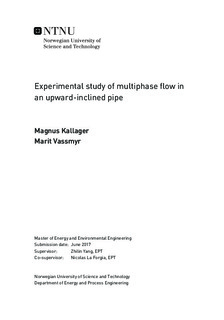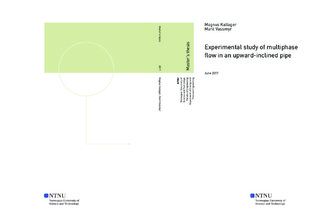| dc.description.abstract | This work has been dedicated to gain knowledge about two-phase flow in an inclined pipe through experimental investigation and adaption of theoretical framework from relevant literature. Two-phase flow experiments with viscous oil and air were carried out in a 6 m long, 60 mm ID pipe with inclination angles ranging from 10 to 78. The oil density and viscosity was 836 kg/m^3 and 0.025 Pa s, respectively. The superficial oil velocities were in the interval 0.017 m/s - 1.34 m/s while superficial air velocities ranged from 0.028 m/s - 10.78 m/s. The observed flow patterns comprised stratified wavy from 10 - 20angle, cap bubble flow from 10 - 60 angle, elongated bubble flow from inclinations 10 - 30, severe slug flow from 45 - 78 angle, churn flow at inclinations 70and 78, while slug and annular flow were observed for the entire range. Flow regime maps were produced for all pipe inclinations.
An important purpose of the investigation was to validate a unified model from the literature and it was observed that the flow regime predictions from the unified model was in good agreement with the measurements. Overall, the bubble-slug flow transition at inclination 45-78 was highly equivalent with measurements. The transition to stratified flow was predicted at lower oil flow rates compared to the measurements, although the maximal inclination angle for stratified flow regime agreed quite well. The objective was also validating measurements with simulations in OLGA. The results showed that flow regime simulations in OLGA were not in sufficient agreement with the measurements. OLGA predicted stratified flow for inclination angles up to 45, and annular flow transition was achieved at significantly higher gas flow rates than the measurements. One reason could be the different classification of the flow regimes. The capacitance sensor were used to classify flow regimes and calculate liquid holdup and pressure drop. It was found that the accuracy of liquid holdup correlations can be improved by considering each flow pattern.
Pressure drop measurements showed that two-phase oil-air flow gave lower total pressure drop compared to single phase flow for inclinations. This was more significant for low liquid flow rates and higher inclination angles. The total pressure loss reached a minimum point for lower gas flow rates and an increase in gas flow rates resulted in larger pressure drop for all inclinations. In this area, the frictional losses became more dominant. Small gas and liquid flow rates gave positive frictional pressure gradients. OLGA simulations showed the same trends as the experiments. Although the experiments and OLGA were in good agreement at low flow rates, the deviation in frictional pressure gradient was significant for medium and high gas flow rates. This resulted in deviation in the total pressure gradient. One reason could be simplifications of the experimental results, where averaged values were used. | |

